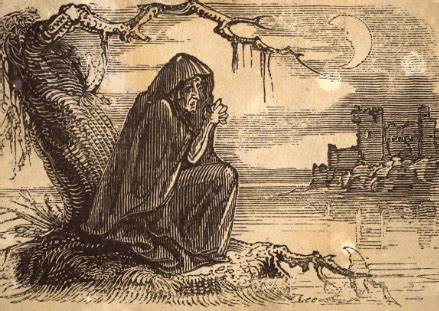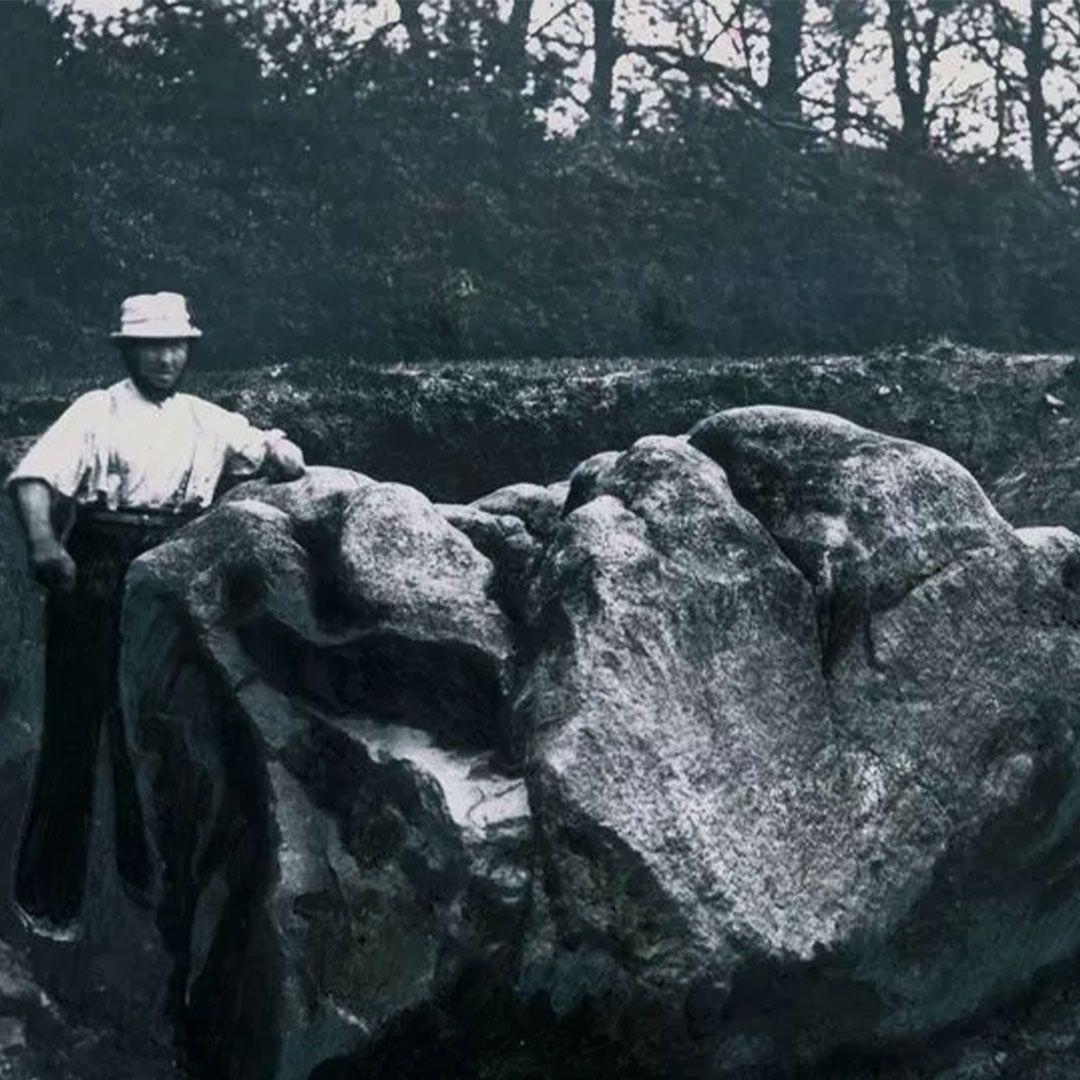The Mythstorians
During our work looking into our history and the wider story of Leicester, YMCA Leicestershire resident Lexi was particularly drawn to the myths and folklore of the local area. They became the projects self-styled Mythstorian – researching and presenting the stories you see here. You can hear more about these tales on the Hidden Gems Podcast.
Black Annis

Black Annis (also known as Black Agnes or Black Anna) is a bogeyman figure in English folklore. She is imagined as a blue-faced hag or witch with iron claws and a taste for human flesh, especially children. She is said to haunt the countryside of Leicestershire, living in a cave in the Dane Hills with a great oak tree at the entrance. Black Annis is known for her terrifying wails and screeches that echo from the hills.
She is said to venture out at night looking for unsuspecting children and lambs to eat, then tanning their skins by hanging them on a tree before wearing them around her waist. The legend also claims that she would reach inside houses to snatch people, particularly children. Locals believed that Black Annis reached into their windows at night to capture them, prompting parents to use the tale to scare misbehaving children into obedience. It is also said that some houses in Leicestershire have small windows to deter Black Annis from entering.
Her home, known as Black Annis’ Bower Close, was reportedly dug out of a sandstone cliff with her iron claws. The oak tree near her cave was said to be a hiding spot from which she would leap onto her unsuspecting prey.
First Reference to Black Annis / Origins
The earliest known written reference to Black Annis comes from an eighteenth-century title deed that referred to a parcel of land as “Black Anny’s Bower Close,” dating back to May 13th and 14th, 1764.
There is some uncertainty about the origins of Black Annis. Some experts relate her to Danu in Celtic mythology, while others associate her with Hel in Norse mythology. According to historian Ronald Hutton, the legend of Black Annis may have originated from a real person named Agness Scott, a Dominican nun who lived in solitude and cared for a community of lepers in the caves of Dane Hills. Over time, her story became distorted, transforming her into the terrifying figure of Black Annis.
Where is the Witches Cave?
Many locations have been proposed as the home of Black Annis. One of the most widely attributed sites is Scraptoft Witches Cave, located in a small forest near the village of Scraptoft in Leicestershire. The village is roughly 5 miles east of Leicester city center and has a population of around 2,000 people.
The Humber Stone

The Humber Stone is a stone in Hamilton with a history tied to witches, curses, fairies, and punishment for those who meddle with it. While it lends its name to a part of Leicester, the Humber Stone is likely one of the oldest local landmarks, though it’s not widely known, possibly due to a macabre curse attached to it. If the legends are to be believed, it’s easy to understand why.
Where is it?
The Humber Stone is believed to be an erratic—a large block of rock transported by a glacier and left behind when the ice retreated. This likely occurred around 440,000 years ago during the Anglian Ice Age, when thick ice sheets covered Leicester. The rock is made of syenite granite, and the nearest source of this material is Mountsorrel, located five-and-a-half miles away.
According to folklore, many have lost their livelihoods—and even their lives—after messing with the ancient stone. The 20-tonne rock, left in proto-Leicester by a glacier, still stands today on Sandhills Avenue, off Thurmaston Lane. Though it may appear to be just a large lump of rock, it represents centuries of stories, most of them steeped in ill fate.
Strange happenings surrounding the Humber Stone are said to include ghostly apparitions and mysterious disappearances. One tale involves a group of local children who dared to touch the stone on a dare. Shortly after, they reported hearing whispers and seeing shadowy figures move around them, prompting them to run in fear. Another story tells of a man who, after trying to move the stone, was struck with an unexplained illness that left him bedridden for weeks. Locals believe that these events are the result of the stone’s curse, punishing those who try to alter or disturb it.
They say there’s no smoke without fire, and that certainly seems true for the Humber Stone.
In the Mystery of the Humber Stone, by John Harrison there is a story of a farmer in 1925 who decided to build a haystack on the stone. The stack burst into flames. The fire brigade was called, but as soon as they had extinguished the fire and left, it burst into flames once again.
The 9 O’clock Horses

Initial research into this feat, which we had misunderstood to be the Midnight Horses prompted us to look into a folklore tale found in several different cultures.
One of these was the Wild Hunt. From my understanding, many different cultures have stories of riders being seen late a night passing through the country side and are seen as a sign or omen of misfortune coming. The riders identities change depending of who you ask, being gods, faeries spirits who have passed or even figures of legend. An early English reference to this comes from The Peterborough Chronical Henry D’Angely in 1127. Many men both saw and heard a great number of huntsmen hunting. The huntsmen were black, huge, and hideous, and rode on black horses and on black he-goats, and their hounds were jet black, with eyes like saucers, and horrible.
On further research we became aware of the 9 o’clock horses.
“Switch out your light, come kiss me good-night, the nine O’clock horses are taking flight”
Often used as a way to get children to go to bed, you may have heard “get to bed or the 9 o’clock horses will get yer“.
Through the early 1800’s The city of Leicester had grown and grown, and didn’t have a proper sewage system that could cope with the increasing population. Human and animal waste was collected in gardens or on the streets and would cause lots of pollution and illness, and although not as densely populated as other industrial cities, Leicester did have the 4th Highest mortality rate in the country between the years 1840 – 1842.
During this time Night soil men would come and take away this waste from the streets of Leicester but there was a Law in place that they could not enter the city before 9 o’clock to make their collection. As for the stories of Children being taken away, there is a possibility that this isn’t just part of the myth. The populations in the countryside had begun to fall as people moved into the city as part of the industrial revolution. There was therefore a lot less people to work on farms. At that time there weren’t many or any child labour laws, and it wasn’t uncommon for any children on the streets to be taken and put to work on farms for food and somewhere to sleep.
Leicester got it’s first sewage treatment in 1855 engineered and built by Thomas Wicksteed, and then with the addition of Abby pumping station in 1891, there was no longer a need for Night soil men but the story of the horses has been kept as a bedtime bogy man long after.
The Woman In White

When growing up in Leicester, you often hear the tale of the Woman in White, but the more you research, the more you realize she is not just one woman. Instead, she represents a collection of stories, each with different meanings—some warnings for women, others about hurt women—but they are all referred to as the White Woman.
Where is the White Woman?
One of these stories is about the White Woman of Belgrave, an area rich with historical landmarks like Abbey Pumping Station, Belgrave Hall, and St. Peter’s Church. It’s no surprise that the area would be home to a ghost of its own. The most common sightings of the Woman in White occur on the grounds of Belgrave Hall, particularly where she is said to walk through the walls of the hall to the garden.
There is also a medieval legend that suggests the Woman in White appears in the house of a family with a member who is due to pass away. Some believe that she is actually an ancestor who has returned to offer comfort and guide the deceased to the afterlife.
Other versions of the tale describe her as a bride or bride-to-be who met a tragic end. In this version, she is said to be gentle around women but hostile and angry around young men, often scaring them away by screaming. This could be a tale to warn men not to harm innocent women or a cautionary message for women to be careful who they trust. Regardless, the trauma and pain she endured seem to have kept her bound to the earthly realm.
Conclusion
I would consider this more folklore than fact, as trying to pin down specifics only leads to a variety of different stories. The one consistent element is that the White Woman is a figure who died while wearing a white dress and now represents pain, loss, and betrayal. What’s fascinating is that variations of the White Woman tale exist in many cultures worldwide. This suggests that these stories might have evolved over time, blending together like a game of Chinese whispers. Any underlying meaning or warning has likely been lost to time.
Listen To The Hidden Gem Podcast
Dive into our archives and uncover stories, events, and treasures from the Hidden Gems project—your gateway to exploring Leicestershire’s heritage.